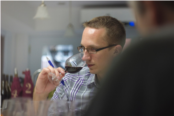In the previous column, I briefly describe some of the terms used to describe wine. This is only a brief overview of the vocabulary used in the field. Even if it’s only to learn more about wine or just to dazzle the stepmother, it may be interesting now to learn some terms related to winemaking that is to say, the process of winemaking.
Here is a interesting glossary, which I hope you will learn more about this wonderful world.
Alcoholic fermentation: Process allowing the grape juice to become wine by the action of yeast converting sugar into alcohol.
Grape variety: Variety of vine. There are countless varieties, created by evolution and natural selection of the vine.
Lees: Deposits consisting of the dead yeast when it has finished the fermentation process. Some wines are matured sur lie (on the lees) to enrich their aromas. The lees also help stabilize the wines.
Maceration: Stage of red wine production in which the solid parts of the grape are in contact with the juice to impart their aromas, color and tannins.
Malolactic fermentation: Transformation of malic acid into lactic acid and carbon dioxide, the effect is to make the wine less acidic.
Maturation: Operations that begin after malolactic fermentation and when the wine is bottled. Maturation is designed to stabilize the wine, clarify it and encourage the creation of more complex aromas that increase the quality of the wine. This maturation, which occurs in a vat or barrel, must be distinguished from bottle maturation, during which the wine continues to evolve and produce new aromas once it has been bottled.
Moût: The sweet pulpy liquid extracted from the grape once the stems have been stripped away.
Passerillage: A process in which grapes are air-dried and shriveled after harvest to increase their sugar concentration. This takes place in a dry, well-ventilated area in order to avoid spoilage.
Saignée: Rosé de saignée. A rosé produced from red grapes that undergo a short maceration so that the wine acquires some of the pigments, but no tannins. These rosés are more powerful than the rosés de pressurage, which are rosés produced from red grapes using the production method for white wines.
Terroir : A territory that is distinguished by certain physical, topographical, and microclimatic conditions. These come together to make wines with unique personality and organoleptic qualities.
Vintage: Term that describes both the year of the actual grape harvest and the wine made from those grapes.
Yeast: microscopic unicellular fungus causing fermentation.
Some suggestions
White wine
Domaine de Bellevue – Saint-Pourçain 2013 – 17,15$ - Code SAQ : 10273256
Excellent wine from Jean-Louis Pétillat, from a small unknown appellation of the Loire: Saint-Pourçain. This vintage "Grand Reserve" is derived from a blend of Chardonnay, Sauvignon Blanc and Tressallier. Sauvignon brings aromas of fresh herbs and citrus, while the Chardonnay brings a roundness and a very nice structure. Long finish it will go well with grilled scallops simply seasoned with butter, salt, pepper and lemon zest.
3.5/5
Red wine
Kaiken Ultra Malbec 2011 – 20,65$ - Code SAQ : 11156756
Hurry to get your hands on a few bottles of this fine nectar. This is an excellent value for a Malbec. It comes from Argentina, but more specifically in the region of Mendoza. This region alone produces over 70% of the wines from Argentina. Generous, tender, spicy and delightful, it can satisfy those who love serious fruity wine. As it is a tradition in Argentina, it will be the perfect match for grilled beef.
3.5/5
Cheers!


